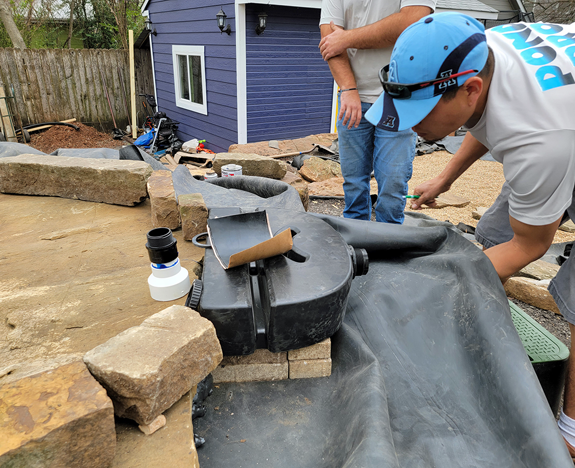
I’ve been building ponds commercially since 2000 and this is a first time request: a grotto feature. This request came as a surprise as Texas Ponds and Water Features started talking about a backyard recreational pond early last year and we had a pretty good idea of the features wanted. The client wanted a wetlands filter. No problem. They wanted an intake bay. No problem. They wanted a deep part and some shallower parts for the kids. No problem. And they wanted a grotto. Hmmmm.
The only pond grotto that I’ve seen is the one at Aquascape’s AquaLand in St. Charles, IL and we – Juan “Mando” Sanchez and I – were lucky enough to have been involved with that pond project in 2008. Texas Ponds and Water Features saw how that grotto was built, but it wasn’t going to work in our clients’ situation. So we set out to build a sort of miniature version of that grotto.
Grotto Integration
After the wetlands filter was mostly complete, we started to build a frame for the grotto and dug a form into the ground to create a concrete pad. Before pouring the concrete, we set out the first row of cinder blocks that would become the walls of the grotto and marked the ground where the rebar would go up into the bricks. We removed the bricks, stood up the rebar in the soil and poured the pad. After the pad was dry, Mando and Coby created the walls and filled them with concrete.

While this was going on, I found a couple of rocks that went together almost perfectly to form a sort of ‘stone couch’. This was a great time-saver because we had originally planned to do the interior with stacked stone called the “Gerard-style” that is very time-consuming.
We decided to pour another concrete pad for the back rock, so that it didn’t settle and once dry we were ready to install those two stones. But first, we had to get the edge of the liner underneath everything and only a little part of the pond had been dug at that point, so we had to unroll the liner and just pull one edge of it into the grotto. The 40×50′ liner was a challenge for a three-person crew.
We managed to get the liner in place and strapped up the stones. It was a very tight squeeze as there was only a little over an inch of clearance on each side of the stones. One wrong move and we could have broken the walls, but they went in perfectly.
I had picked out two magnificent rocks to be the frames of the grotto and we moved them into place to mock up the layout before the liner was in place just to make sure everything was going to fit. Once the liner was installed, they went right back into their places and we could really start seeing the grotto coming together.

Now was the time to create the roof of the grotto that would support the flat stone on top. We created a wooden floor using plywood supported by 4x4s, and then built a frame around the floor. To keep the concrete from leaking between the floor and sides of the frame, we used waterfall sealing foam. Rebar was suspended in the middle, poured concrete and let it dry for over a week while we worked on other aspects of the pond.
The crew put sealer on the concrete and painted the front edge black to help it disappear once the water started flowing. Liner was installed on the top of the grotto so that we could connect it to a waterfall diffuser spillway and make sure that all the water went off the front. We could finally install the large stone that would be the lip of the waterfall.
We overhung the front of the concrete to create more space in the grotto, while the spillway was attached and stones placed around to support everything.
Inside the grotto, I painted the walls to better match our stones and used brushes to paint cracks into the walls. We used roots from the tree that had been recently removed from the site and “Gerard-style” stacked stone to complete the cave-like feel of the interior. Mando finished the outside with boulders and stacked stone and even incorporated a few pots to install plants that will help naturalize the large stone structure.

The waiting was definitely the hardest part. The crew had to finish the pond, wetlands filter and intake bay before we could turn any of it on because we were using a single, Aquascape 18,000 gph external pump. This pump would power the grotto waterfall, the wetlands filter, stream and waterfall that flowed from it, and some sub-surface jets that would keep water moving in some otherwise dead areas. We also had to wait for the electricians to come hook up the pump.
Turning it on was the culmination of months of work and anxiety over whether it would work the way we wanted it. The crew turned the pump up to half power and ran around checking everything for leaks before turning it up to full power. I gotta admit that I feel lucky that it all worked as planned and it looks great, and the clients love it!
But, we’re not stopping there as we’re already building a pondless grotto waterfall for another client! Follow our Instagram to see how this one turns out!







